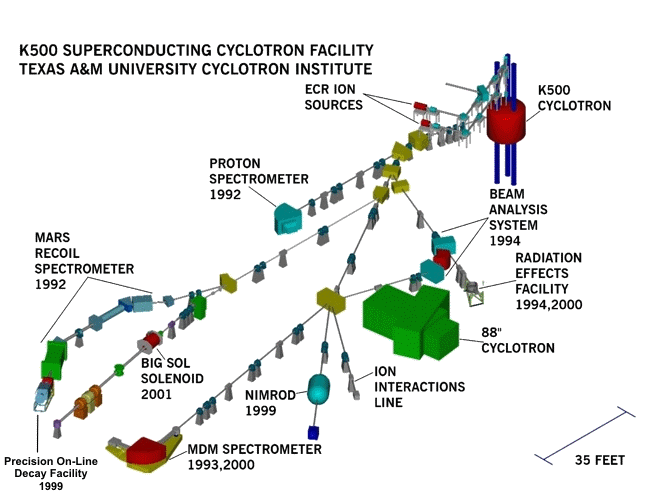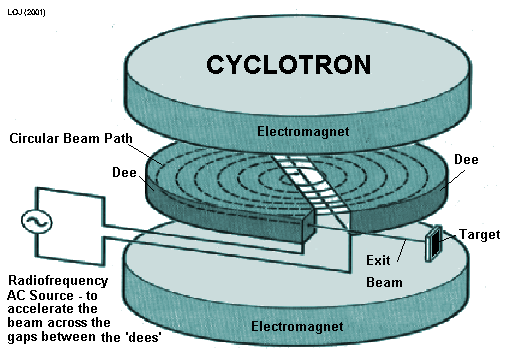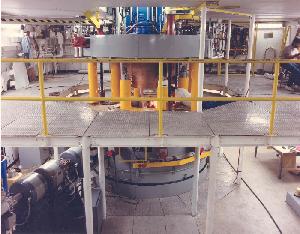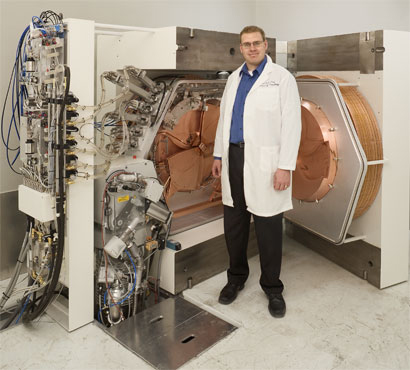A cyclotron
is an accelerator for charged particles.
A proton
beam was used almost exclusively for physics research until the
early sixties. Since that time there has been an increasing interest
in using protons for medical radiotherapy.
A cyclotron
is linked to other facilities such as spectrometers where work
on the particles produced is done (see diagram of the Tex
as A&M
University Site below).

The K500
Cyclotron (illustrated above) is capable of supplying a variety
of ion beams to the experiments at its Cyclotron Institute. Starting
from the ECR ion sources, ion beams of the very lightest elements
to ion beams of the very heaviest of elements can be accelerated
by the cyclotron to high energies.
Beam energies for protons (ionized
hydrogen) can range from 8 MeV to 70 MeV depending on the settings,
while energies for uranium ions can range from 500 MeV (2MeV per
nucleon) to 3.5 GeV (15 MeV per nucleon).
At the heart
of the cyclotron is a superconducting magnet whose intense magnetic
field holds the ions in orbits between its poles. The 50-kilogauss
magnetic field is generated by 800 Amperes of electrical current
carried by 5500 turns (25 miles) of niobium-titanium superconducting
wire in a coil surrounded by 100 tons of steel (Faraday cage).
The acceleration of the ions is accomplished by intense, rapidly
alternating electric fields generated by a 240-kilowatt radio-frequency
system and impressed upon hollow copper structures called 'dees'
located between the poles of the magnet. The generation, injection,
acceleration and delivery to target of the ions takes place in
high vacuum, while the path and focus of the beam outside the
cyclotron is controlled by high-field, electromagnets.
Physically,
a cyclotron weighs about from about 50 -120 tons (depending upon
its date of manufacture and its capabilities - they are getting
bigger and better all of the time!), and is located inside an
inner vault with walls and doors of about 2 m concrete, to shield
the surroundings from the nuclear radiation which is present when
the machine runs. Fortunately, most of this radiation has a half-life
of only seconds to minutes, so there are no long-term waste disposal
problems.
The
operating principle is illustrated below.

The ions
(charged particles) are injected by an ion-source near the center
of the machine (can't be seen clearly in this diagram). As they
are charged and in a magnetic field they obey the formula:
F
= qv x B
where
F is
the force vector,
q is
the charge,
v is
the velocity vector and
B is
the magnetic flux density vector.
Particles immediately
start going in circular orbits. (The force is applied at right
angles to their path - therefore they are forced into a circle)
For most
of their orbit, the particles move within a hollow D-shaped metal
electrode, called a "D" (or "dee").
Here they
only experience the magnetic field, as they are screened from
any electric field inside the cyclotron by what is known as Faraday
Cage Effect.
The Faraday Cage Effect (named after its discoverer)
means that the electric charge on a conductor sits on the outer
surface of it. Therefore, no electrostatic field is present within
the conductor. Only when the particles move in the small gap between
the dees, they are influenced by an electric field applied from
one dee to the other.
We
will then get an acceleration of the particles, according to:
F
= qE
where
F is
the force vector,
q is
the charge and
E is
the electric field intensity vector.
There will
only be maximum acceleration if the electric force has the same
direction as the velocity. Therefore, the electric field must
change its direction while the particles are screened inside the
dees so that the electric field (the dee-voltage is typically
~ 100 kV) can be applied in one direction as it leaves the one
'dee' and be in the opposite direction by the time it leaves the
other 'dee' half a cycle later. This means that the electric field
has to oscillate with a frequency corresponding to the particles'
revolution frequency. In practice his frequency is in the radiofrequency
range (typically in the range 12 - 24 MHz, in the middle of the
shortwave band).
Now, the
magnetic force is equal to the centripetal force of the circular
movement (it is what makes it move in a circle!), so we get the
cyclotron equation from equating the two:
Centripital
force = mv2/r
Magnetic
force = Bvq
\
mv2/r = Bvq
Cancelling
a ' v ' and rearranging we have
r = mv/qB
where r is the
radius of the particle orbit.
As we can
see from this, as the particles increase their velocity (because
they have been accelerated between the 'dees' their radius will
increase as radius is proportional to their velocity.
This is
repeated until they after typically a few hundred orbits reach
the energy desired. They can then be extracted by a new electric
field combined with a magnetic field, and be transported through
a beam tube to the point where they are to be used to initiate
nuclear reactions.
The beam line is a straight steel tube of diameter
about 10cm, in which vacuum of about 0.001Pa is kept, and where
the beam runs from its source (in this case the cyclotron) to
the area where it is used for bombarding target matter.

The
K500 Cyclotron with its upper steel pole cap raised for maintenance.
The exit beam line is at lower left.
Extension
work - especially relevant to those doing relativity in their
option!
Notice that
above equation requires the mass 'm' to be constant for 'v' to be
directly proportional to r. Relativistically, the mass is not constant,
but increases with v. This does not matter for low speeds but is
highly relavant in this context, since for instance 35 MeV protons
have a velocity of about 0.3c.
Medical
uses of the Cyclotron - the manufacture of radioactive materials
 Some
radioactive elements, such as radium, are found in nature, but most
radioactive materials are produced commercially in nuclear reactors
or cyclotrons. With nuclear reactors and cyclotrons, it is possible
to make useful amounts of radioactive material safely and at low
cost - often on site at a large hospital - important when the radioisotope
has a short half life. Some
radioactive elements, such as radium, are found in nature, but most
radioactive materials are produced commercially in nuclear reactors
or cyclotrons. With nuclear reactors and cyclotrons, it is possible
to make useful amounts of radioactive material safely and at low
cost - often on site at a large hospital - important when the radioisotope
has a short half life.
A cyclotron
uses electric current to accelerate charged atomic particles such
as protons, which strike the non-radioactive "target"
material, turning it into a radioactive isotope.
When the non-radioactive
"target" element cobalt is struck by neutrons in a reactor,
it is transformed into a radioisotope (cobalt-60) which is used
to treat cancer and sterilize medical and consumer products.
The difference
between cyclotron and reactor manufacturing is that usually only
one type of radionuclide can be produced at a time in a cyclotron,
while a reactor can produce many different radionuclides simultaneously.
If radionuclides
are produced commercially, they are packaged and safely shipped
to users throughout the country, including hospitals, laboratories,
universities and manufacturing plants, but large hospital facilities
may well have a cyclotron on site if they have equipment such as
a PET scanner..
|


